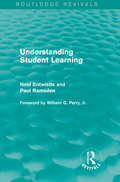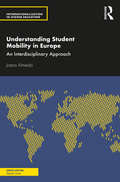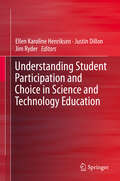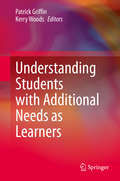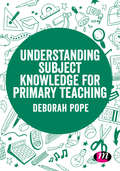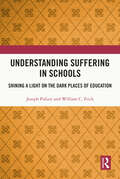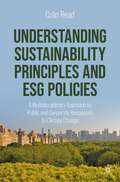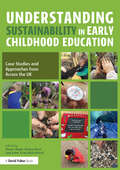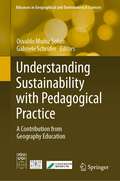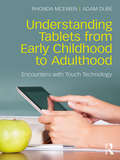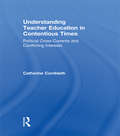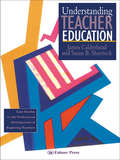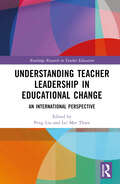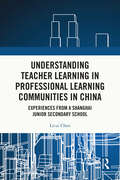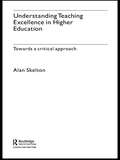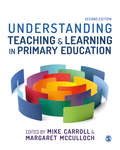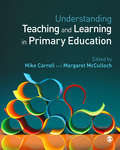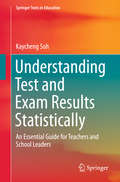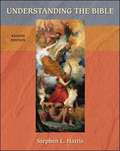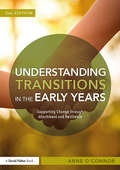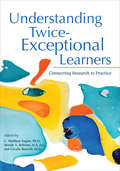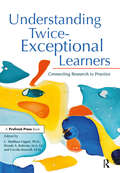- Table View
- List View
Understanding Student Learning (Routledge Revivals)
by Paul Ramsden Noel EntwistleFirst published in 1983, Understanding Student Learning provides an in-depth analysis of students’ learning methods in higher education, at the time. It examines the extent to which these learning methods reflected the teaching, assessment and individual personalities of the students involved. The book contains interviews with students, experiments and statistical analyses of survey data in order to identify successes and difficulties in student learning and the culmination of these techniques is a clearer insight into the process of student learning.
Understanding Student Mobility in Europe: An Interdisciplinary Approach (Internationalization in Higher Education Series)
by Joana AlmeidaUnderstanding Student Mobility in Europe interprets student mobility in European higher education through an active dialogue between disciplines, voices and variables of interest. Providing the conceptual, methodological, pedagogical and empirical foundations, this book advances readers’ understanding of the student exchange experience, whilst outlining guidelines and resources for approaching student mobility and considering how students can gain from cross-border education. Intersecting voices from different disciplines and sojourners, including exchange students, international students and highly skilled immigrants, the book outlines practical guidelines for intercultural curriculum development and assessment, and provides insights, practical ideas, useful terminology and resources to maximise the learning gains of this student population. Split into three distinct parts, the book initially lays the foundational substructure in which an interdisciplinary approach is based. It then addresses questions of practical application by considering the experiences of 50 sojourners in Portugal and the UK through an interdisciplinary lens, and summarises the implications of interdisciplinarity with regards to student mobility in European tertiary-level education. This book is essential reading for academics and postgraduate students interested in student mobility, education abroad practitioners, and policy-makers at institutional, national and international levels.
Understanding Student Participation and Choice in Science and Technology Education
by Justin Dillon Ellen Karoline Henriksen Jim RyderDrawing on data generated by the EU's Interests and Recruitment in Science (IRIS) project, this volume examines the issue of young people's participation in science, technology, engineering and mathematics education. With an especial focus on female participation, the chapters offer analysis deploying varied theoretical frameworks, including sociology, social psychology and gender studies. The material also includes reviews of relevant research in science education and summaries of empirical data concerning student choices in STEM disciplines in five European countries. Featuring both quantitative and qualitative analyses, the book makes a substantial contribution to the developing theoretical agenda in STEM education. It augments available empirical data and identifies strategies in policy-making that could lead to improved participation--and gender balance--in STEM disciplines. The majority of the chapter authors are IRIS project members, with additional chapters written by specially invited contributors. The book provides researchers and policy makers alike with a comprehensive and authoritative exploration of the core issues in STEM educational participation.
Understanding Students with Additional Needs as Learners
by Patrick Griffin Kerry WoodsThis book brings together a compendium of the collaborative research from eight PhD students and three researchers, addressing an existing problem for teachers of students with additional learning needs in mainstream classes. The purpose of this research is to describe the development of growth progressions in communication and literacy, interpersonal skills and understanding of emotions, learning skills, numeracy, movement, digital literacy, thinking and problem-solving skills among students with additional needs in the classroom, known as SWANS (Students with Additional Needs). The research has grown over a decade or more and this volume brings all that research together under a single cover in a way that has not been done before. It shows how work conducted at the same system and school level that led to the design of curriculum support for SWANS, drawing on the research to establish expected learning progressions, was linked to a mainstream curriculum. It also illustrates strategies and materials that could be used by mainstream teachers or special education teachers to make teaching SWANS practical and effective. The book offers new insights, and a ready to use volume of material for curriculum writers, student teachers, researchers, and special education teachers and administrators.
Understanding Subject Knowledge for Primary Teaching (Exploring the Primary Curriculum)
by Deborah PopeHow can trainee teachers begin their careers with a clear understanding of all the curriculum subjects? This book addresses the nature of subject knowledge in all foundation curriculum subjects. It deconstructs the elements of each subject through an exploration of the nature of the subject, a coverage of the 'skills' a study of this subject develops and through detailed analysis of case studies from practice. At a time when concerns about the lack of breadth in the primary curriculum are being voiced, this book supports busy trainee teachers to truly understand and be ready to teach all curriculum areas.
Understanding Subject Knowledge for Primary Teaching (Exploring the Primary Curriculum)
by Deborah PopeHow can trainee teachers begin their careers with a clear understanding of all the curriculum subjects? This book addresses the nature of subject knowledge in all foundation curriculum subjects. It deconstructs the elements of each subject through an exploration of the nature of the subject, a coverage of the 'skills' a study of this subject develops and through detailed analysis of case studies from practice. At a time when concerns about the lack of breadth in the primary curriculum are being voiced, this book supports busy trainee teachers to truly understand and be ready to teach all curriculum areas.
Understanding Suffering in Schools: Shining a Light on the Dark Places of Education
by William C. Frick Joseph PolizziDrawing inspiration from Dr. Willi Schohaus’s classic text The Dark Places of Education, this book contributes to the discussion by defining suffering in schools and providing a survey of the American school system’s inadequacies in the early twenty-first century. Through testimonies from former students on the ways they experienced suffering in school, this volume demonstrates how suffering can profoundly affect one’s academic growth and development—or worse. By analyzing the findings within a multidisciplinary ethical and educational framework, this volume presents a moral vision for understanding the role that suffering plays in school. Drawing on research in medicine, psychology, social sciences, religion, and education, this text weaves together many strands of thinking about suffering. This book is essential reading for academics, researchers, and postgraduate students in the fields of educational leadership, foundations of education, and those interested in both the history of education and critical contemporary accounts of schooling.
Understanding Sustainability Principles and ESG Policies: A Multidisciplinary Approach to Public and Corporate Responses to Climate Change
by Colin ReadThis textbook explores sustainability, climate change, and the corporate responsibility movement from a broad array of perspectives, including the challenges, risks, and opportunities of ESG policies, energy and environmental science, economics and philosophy, and sound public and private sector management. There is no intergenerational issue that is more pressing than the challenge of sustainability and climate change. It is a concern that will only worsen within any reader’s lifetime, especially if we fail to act. At the same time, there is growing concern among corporations arising from the Environment, Social and Governance (ESG) paradigm that includes climate risk, future profits, and stakeholder expectations. Many of our leading institutions also increasingly acknowledge a responsibility for corporate decisions since the onset of the Industrial Revolution that plays no small role in bringing us to the existential precipice of our day. This book provides necessary tools of sufficient sophistication to address complex intergenerational issues, such as global warming, economic justice and fairness, appropriate intergenerational planning, sustainable finance, corporate risk management, and governance. The book offers a vital resource for students, shareholders, sustainability practitioners, agencies, and advocates interested in climate action, intergenerational accountability, and economic sustainability.
Understanding Sustainability in Early Childhood Education: Case Studies and Approaches from Across the UK
by John Siraj-Blatchford Diane Boyd Nicky HirstThis unique book explores research related to education for sustainability within early childhood education in the United Kingdom. Divided into the four home nations, it examines what education for sustainability looks like in practice, discusses the different application and positions of each region, and considers the contribution of early childhood education to support the Sustainable Development Goals. Each chapter considers the relevant early years framework and includes associated case studies which highlight connections between statutory guidance, policy and positive early years pedagogical practice. The authors use an education for sustainability lens to explore the critical issues and explicit and implicit links embedded in each of the curricula frameworks. Each chapter acknowledges the context of outdoor learning with discussion related to different interpretations of ecological sustainability. This exploration should help readers to consider the idea of sustainability within early childhood education. The book considers early childhood education as a distinct and valuable phase beyond the readiness for school discourse and recognises the importance of having skilful and knowledgeable adults to work with young children from birth. It offers a unique resource for students, practitioners, leaders and researchers engaged in the study of education for sustainability in early childhood and the importance of the early years for the development of life-long pro-environmental attitudes.
Understanding Sustainability with Pedagogical Practice: A Contribution from Geography Education (Advances in Geographical and Environmental Sciences)
by Osvaldo Muñiz Solari Gabriele SchrüferThis book shares with an international audience of teachers, scholars, and policymakers the experience of pedagogical practices to facilitate sustainability in the world. Sustainability is seen here as a journey toward the end state of sustainable development. Therefore, the authors contribute different roads to engage teachers and students with pedagogical discourse. Overall, the book demonstrates the value of powerful knowledge through action-oriented learning based on a bottom-up process. Consequently, pedagogical practices are understood as the instructional approaches based on a social constructivist model in which active learning is performed with student-to-student engagement. Secondary teachers in social sciences and university professors in geography find the study to be a valuable source of stimulation for incorporating new ideas and resolving common problems in their learning and teaching environments. Education policymakers around the world also benefit from the only publication that presents international perspectives on geographical knowledge related to sustainability.The contributing authors are experienced scientists in the field of geography education who are giving special attention to pedagogical practices that promote new directions toward sustainable thinking.This book is the first outcome of an international collaboration officially established in 2023 between the Department of Geography and Environmental Studies at Texas State University and the Department of Geography at the University of Bayreuth.
Understanding Tablets from Early Childhood to Adulthood: Encounters with Touch Technology
by Adam Dubé Rhonda McewenUnderstanding Tablets from Early Childhood to Adulthood offers an alternative to dominant and populist narratives that young people are intuitively able to successfully use tablet devices. Adopting a research-driven approach, the book contests the ideology that touch-technologies are easier to understand, and identifies the factors that contribute to communicative encounters between users and tablets. Communication theory and cognitive psychology concepts and methods are employed to offer an epistemological exploration of user-tablet interaction with a focus on the use of these technologies in educational settings.
Understanding Teacher Education in Contentious Times: Political Cross-Currents and Conflicting Interests
by Catherine CornblethUnderstanding Teacher Education in Contentious Times examines how public, professional, and private or corporate agencies operate to shape teacher education and possibilities for its improvement. Teacher education programs, particularly those leading to state certification or licensure, are influenced not only by state regulations but also by required review and accreditation by an outside agency such as the National Council for the Accreditation of Teacher Education, and are subject to various contextual pressures such as the cultures of the institutions that host them and their surrounding communities, their potential student and employer markets, strong individuals, professional organizations, history or tradition, and, increasingly, external, usually privately-funded, special interest corporations such as the National Council on Teacher Quality. Unique among books on teacher education, this volume interweaves—in historical context including emerging trends—the complex contexts in which practice and reform efforts take place and are supported or impeded.
Understanding Teacher Education: Case Studies in the Professional Development of Beginning Teachers
by James Calderhead Susan B. ShorrockThis text reports a study of 20 student primary teachers, 10 on a conventional PGCE course and 10 on a school-based articled teacher training course. documenting their learning experiences over a two year period, the authors explore the factors that facilitate or impede the students' learning as teachers. In drawing upon these case studies together with existing theoretical models of professional development, the authors distinguish several key characteristics of learning to teach and discuss the implications of these for the design of effective school- based teacher education courses.
Understanding Teacher Leadership in Educational Change: An International Perspective (Routledge Research in Teacher Education)
by Peng Liu Lei Mee ThienThis book examines the vital roles of teacher leadership in the ever-evolving landscape of educational change, a constant presence in educational settings. As a cornerstone of school improvement initiatives, teacher leadership is essential; however, research in this field frequently lacks strong theoretical foundations and thorough exploration. This edited volume provides a comprehensive perspective on the roles of teacher leaders in driving educational change.The chapters discuss the competencies required for teacher leadership in turnaround schools, its influence on both school-level and systemic reforms, and the contextual factors shaping leadership development. Additionally, the book provides an in-depth examination of teacher leadership's transformative potential in fostering educational change, offering comprehensive insights into how teacher leaders drive innovation, collaboration, and improvement within schools. By addressing these themes, the volume contributes to a deeper understanding of teacher leadership's role in shaping educational outcomes.This book caters to a wide audience, including graduate students in leadership programs, practitioners, policymakers, and stakeholders involved in shaping educational policies. It offers valuable theoretical insights and serves as a practical reference for those aiming to understand the significant impact of teacher leadership on educational change and improvement efforts.
Understanding Teacher Learning in Professional Learning Communities in China: Experiences from a Shanghai Junior Secondary School
by Licui ChenBased on six-month fieldwork in a junior secondary school in Shanghai, this book qualitatively investigates the implementation of Teaching Research Group (TRG) practices and teachers’ different professional learning experiences within the structure of TRGs. The author situates teacher professional learning in Professional Learning Communities (PLCs) within broader historical, social, and cultural contexts and further suggests that the practice of TRGs reflects the Chinese approach of balancing the seemly complex dualities (e.g., commitment and control, collaboration and authority, individual and collective approaches) in educational settings. This book supplements the present knowledge base on PLCs in the context of China and thus enriches the global discussion on constructing effective PLCs for teacher professional learning and development. Scholars and students studying teacher professional learning and development, professional learning communities, school improvement, and Chinese schooling would find this book helpful.
Understanding Teaching Excellence in Higher Education: Towards a Critical Approach (Key Issues in Higher Education)
by Alan SkeltonWhat makes a university teacher 'excellent'? As debates rage about whether this is down to subject knowledge, communication skills, taking a research-led approach or being a technological whiz, this book provides the first in-depth examination of teaching excellence in higher education. Identifying and examining interpretations of teaching excellence, it considers what ‘excellent’ means and implies for practice.
Understanding Teaching and Learning in Primary Education
by Mike Carroll Margaret McCullochThis textbook gives you guidance and insights into the knowledge, values and commitments necessary to succeed in the primary classroom, supported by links to theory and research literature and realistic scenarios you may encounter as a new teacher. Fully updated throughout, key features of this second edition include: · A new chapter on inclusive education · Newly expanded coverage of digital learning, engaging with educational research and the role of the primary teacher · New ‘View from Practice’ examples · Cross-referenced links to the Teachers’ Standards in England and the GTCS Professional Standards in Scotland and where they are covered within the book This is essential reading for professional studies modules on primary initial teacher education courses, including university-based (PGCE, PGDE, BA QTS, BEd), school-based (SCITT, School Direct) and employment-based routes into teaching.
Understanding Teaching and Learning in Primary Education
by Mike Carroll Margaret McCullochThis textbook gives you guidance and insights into the knowledge, values and commitments necessary to succeed in the primary classroom, supported by links to theory and research literature and realistic scenarios you may encounter as a new teacher. Fully updated throughout, key features of this second edition include: · A new chapter on inclusive education · Newly expanded coverage of digital learning, engaging with educational research and the role of the primary teacher · New ‘View from Practice’ examples · Cross-referenced links to the Teachers’ Standards in England and the GTCS Professional Standards in Scotland and where they are covered within the book This is essential reading for professional studies modules on primary initial teacher education courses, including university-based (PGCE, PGDE, BA QTS, BEd), school-based (SCITT, School Direct) and employment-based routes into teaching.
Understanding Teaching and Learning in Primary Education
by Margaret Mcculloch Mike CarrollThis textbook supports your initial teacher education by providing guidance and insight into the professional knowledge and understanding, skills and abilities, and values and commitments necessary in order to succeed in the primary classroom. Coverage includes: View from practice boxes in every chapter exploring real-life examples of intelligent and engaging teaching in schools Thinking points and reflective questions challenging you to engage critically with what you have read and apply it to your own teaching Links to further reading connecting you to specialised literature on every chapter topic Clear discussion of education policy differences across the UK. Mike Carroll is the PGDE (Primary and Secondary) Programme Leader and Director of the MEd Professional Learning and Enquiry programme in the School of Education, University of Glasgow. Margaret McCulloch is a University Teacher within the School of Education, University of Glasgow.
Understanding Test and Exam Results Statistically
by Kaycheng SohThis book shares the goal of the classic text How to Lie with Statistics, namely, preventing and correcting statistical misconceptions that are common among practitioners, though its focus is on the educational context. It illustrates and discusses the essentials of educational statistics that will help educational practitioners to do this part of their job properly, i. e. , without making conceptual mistakes. The examples are cast in the school/classroom contexts, based on realistic rather than theoretical examples.
Understanding The Bible (Eighth Edition)
by Stephen L. HarrisThis best-selling nonsectarian guide is designed for students undertaking their first systematic study of the Bible. Placing each book of the Old Testament, Apocrypha, and the New Testament fully in its historical and cultural context, Understanding the Bible acquaints readers with the content as well as the major themes of each biblical book, and familiarizes them with the goals and methods of important scholarship.
Understanding The Scriptures (Semester Edition)
by Scott HahnPart of the Didache series. Presenting a Catholic approach to Scripture and highlighting the theme of covenant, Understanding the Scriptures: Semester Edition will provide an understanding of Sacred Scripture so critical to the Catholic Faith.
Understanding Transitions in the Early Years: Supporting Change through Attachment and Resilience
by Anne O'ConnorThere are many transitions that children experience before they are five, including the first major transition from home to an early years setting. Successive changes can have a serious impact on young children and stress, separation and insecure attachments can affect not only a child’s emotional health but also cognitive and intellectual development. Featuring new material on provision for two year olds, school readiness, and families and transitions, this thought-provoking text explains why transitions matter and provides practical guidance on how to support young children’s developing emotional resilience and equip them to embrace change in the future. Aimed at practitioners and students, this fully-updated second edition: draws together evidence from neuroscience, attachment theory, child development and childcare practices; provides a context for practitioners to empathise with children and families as they relate to their own understanding of the impact of change and transition; looks at ways to reduce the number of transitions including the key person approach, and; offers guidance and practical strategies for practitioners, managers and head teachers for supporting children through transitions. Including case studies, examples of good practice and questions for reflection, Understanding Transitions in the Early Years emphasises the little things that practitioners can do for the individual children in their care, helping them to feel secure and confident when dealing with change.
Understanding Twice-Exceptional Learners: Connecting Research to Practice
by Wendy Behrens Cecelia Boswell C. FugateUnderstanding Twice-Exceptional Learners offers an in-depth look at the needs and lived experiences of students who are twice-exceptional. This book:Includes detailed examinations of co-occurring disabilities commonly found in twice-exceptional populations.Features studies of ADHD, dyslexia, dyscalculia, autism spectrum disorders (ASD), anxiety, OCD, and more.Bridges the divide between research about and practical strategies for teaching gifted students with learning challenges.Is Ideal for university teacher preparation courses and graduate programs.Provides strength-based strategies that focus on students' unique gifts and talents.Each chapter includes a comprehensive literature review, suggested interventions, resources for further exploration, and vignettes that highlight experiences of twice-exceptional students and the behaviors and needs that practitioners might commonly see in the classroom.
Understanding Twice-Exceptional Learners: Connecting Research to Practice
by Wendy Behrens Cecelia Boswell C. Matthew FugateUnderstanding Twice-Exceptional Learners offers an in-depth look at the needs and lived experiences of students who are twice-exceptional. This book:Includes detailed examinations of co-occurring disabilities commonly found in twice-exceptional populations.Features studies of ADHD, dyslexia, dyscalculia, autism spectrum disorders (ASD), anxiety, OCD, and more.Bridges the divide between research about and practical strategies for teaching gifted students with learning challenges.Is Ideal for university teacher preparation courses and graduate programs.Provides strength-based strategies that focus on students' unique gifts and talents.Each chapter includes a comprehensive literature review, suggested interventions, resources for further exploration, and vignettes that highlight experiences of twice-exceptional students and the behaviors and needs that practitioners might commonly see in the classroom.
